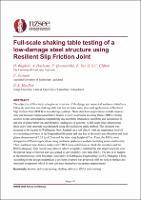| dc.description.abstract | The objective of this study is to give an overview of the design and numerical analyses related to a full-scale steel structure shaking table test that includes some structural applications of Resilient Slip Friction Joint (RSFJ) as low-damage systems. These structural applications include tension-only and tension/compression braced frames as well as moment resisting frame (MRF). During seismic events deformation compatibility and members interaction, members and connection in- and out-of-plane behavior, and dynamic loading are of concern. A full-scale three-dimensional three-story steel structure was designed using the equivalent static method. The structure was assumed to be located in Wellington, New Zealand on a soil class C with an importance level of two including two bays in the longitudinal direction and one bay in the transverse direction and total planar dimensions of 7.25 by 4.75 m and the inter-story height of 3 m. Then, the RSFJs were designed in different applications using nonlinear push-over analysis including joints nonlinearity. Then, nonlinear time-history analysis (NLTHA) was undertaken to check the members and the RSFJs adequacy. One record was selected which acceptably matched the site target spectrum over the period range of interest and was scaled to serviceability limit state (SLS). The test is to happen at the International Joint Research Laboratory of Earthquake Engineering (ILEE), Shanghai, China. According to the design undertaken, a resilient structure was proposed with no need to replace any structural component which in turn can meet immediate occupancy requirements. | |

